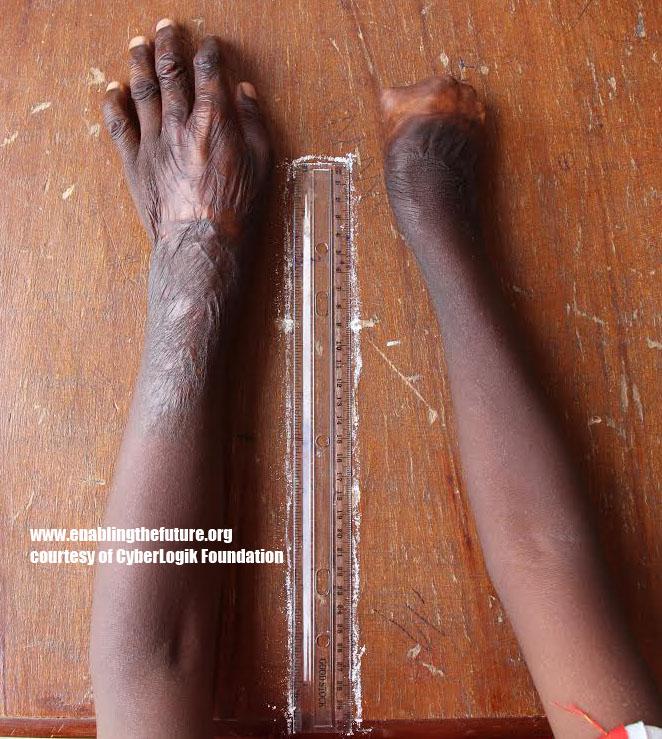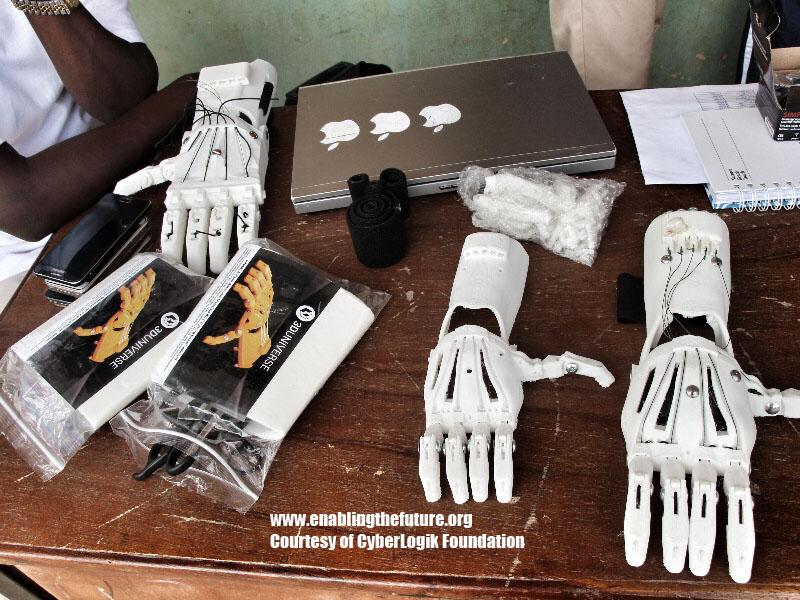When being bombarded with the latest evidence of humanity’s nasty and brutish side, it can be hard to remember that there are gleaming moments among the trash. The news media doesn’t seem to have figured out a way to make money off of too many heartwarming stories and so we are often left with the impression that our best bet is to close ourselves off from our fellow human beings and to view everyone with a deep sense of mistrust.
While I am not suggesting that we all put on rose colored glasses and act the part of an ignorant Polyanna, one of the things that is so nice about writing for 3DPrint.com is that I, more often than not, get to write the stories that demonstrate man’s humanity to man [sic] and not the dregs of human behavior.
 This story too starts out in tragedy, with the flight of families who had lost their homes in Adamawa State, in the northeastern part of Nigeria, when their village was burned to the ground by Boko Haram insurgents. One day, a member of the CyberLogik Foundation, a charitable organization in Nigeria dedicated to humanitarian relief through technology, noticed a 12-year-old boy named Musa who was missing the fingers on his right hand. Musa lost his fingers as the result of an accident that occurred eight years prior when he fell into an open fire. It took four months in the hospital to nurse the boy back to health, but in the meantime, gangrene had claimed his fingers.
This story too starts out in tragedy, with the flight of families who had lost their homes in Adamawa State, in the northeastern part of Nigeria, when their village was burned to the ground by Boko Haram insurgents. One day, a member of the CyberLogik Foundation, a charitable organization in Nigeria dedicated to humanitarian relief through technology, noticed a 12-year-old boy named Musa who was missing the fingers on his right hand. Musa lost his fingers as the result of an accident that occurred eight years prior when he fell into an open fire. It took four months in the hospital to nurse the boy back to health, but in the meantime, gangrene had claimed his fingers.
 A member from the team of visitors from the CyberLogik Foundation, Umar Khalifa Yakubu, saw an opportunity to assist and offered to see what help could be had to address the loss of the capabilities of his damaged hand. Searching the internet, Yakubu came across the vast e-NABLE community, a “world wide movement of tinkerers, engineers, 3D print enthusiasts, occupational therpists, university professors, designers, parents, families, artists, students, teachers and people who just want to make a difference.” The e-NABLE project began with the creation of one prosthetic hand for a young child in South Africa and then the plans for that prosthetic were made freely available to the public so that anyone, anywhere could potentially have access to the device.
A member from the team of visitors from the CyberLogik Foundation, Umar Khalifa Yakubu, saw an opportunity to assist and offered to see what help could be had to address the loss of the capabilities of his damaged hand. Searching the internet, Yakubu came across the vast e-NABLE community, a “world wide movement of tinkerers, engineers, 3D print enthusiasts, occupational therpists, university professors, designers, parents, families, artists, students, teachers and people who just want to make a difference.” The e-NABLE project began with the creation of one prosthetic hand for a young child in South Africa and then the plans for that prosthetic were made freely available to the public so that anyone, anywhere could potentially have access to the device.
In a refugee camp in East Africa, however, it is not as simple as sending the files off to Shapeways or running down to the local 3D print hub. There are some significant difficulties in accessing and operating 3D printers there, as Yakubu explained:
“A lot of companies selling 3D printers, filament and parts do not ship to Nigeria. We have to ship to a warehouse in the US and ship to Nigeria using additional delivery services that charge extra. 3D printer companies also do not support Africa, so we cannot get solutions from them on technical issues or do a part swap when our parts fail. We have to buy new parts since we cannot get them fixed.”
This is the difficulty with high-tech solutions. They are wonderful when they work, but to reach those who need them most is complicated by lack of infrastructure and support. In addition to the challenges of getting materials and maintaining machines, the supply of power in the area is highly unstable, meaning that there is a need to provide a source of secondary, back-up power to get the machines through the outages without interrupting the print.
 These safeguards are necessary because of the extremely high costs of shipping that make the filament an extremely precious commodity. The print of a single prosthetic device can take anywhere from 12 to 20 hours of continuous printing time and require about one quarter of a filament spool. That’s a long time to maintain power in a region where outages are the norm and the loss of one print takes quite an economic toll on those who are trying to provide them for free. It’s not a challenge that either CyberLogik or e-NABLE are willing to walk away from.
These safeguards are necessary because of the extremely high costs of shipping that make the filament an extremely precious commodity. The print of a single prosthetic device can take anywhere from 12 to 20 hours of continuous printing time and require about one quarter of a filament spool. That’s a long time to maintain power in a region where outages are the norm and the loss of one print takes quite an economic toll on those who are trying to provide them for free. It’s not a challenge that either CyberLogik or e-NABLE are willing to walk away from.
Yakubu shared his cautious optimism for the possibilities created by 3D printed prosthetics:
“The number of amputees in Africa is the greatest in the world. There are not enough people making prosthetic limbs, even for the people who can afford it…in countries like Mali, Uganda, CAR, Eritrea, Nigeria, Burkina Faso, Sierra Leone, Liberia, and other poor countries with recent histories of war, disease, extreme poverty and terrorism. e-NABLE has been an awesome experience and this is only the beginning. 3D printing is the ‘future of the future’ and we are excited to be part of the journey.”
For 12-year-old Musa and his family, the results have already been dramatic and stand as an example of the ways in which people help each other, even when they don’t have to, just because it is the right thing to do. Discuss this story in the 3D Printed Prosthetic Forum on 3DPB.com.
Subscribe to Our Email Newsletter
Stay up-to-date on all the latest news from the 3D printing industry and receive information and offers from third party vendors.
Print Services
Upload your 3D Models and get them printed quickly and efficiently.
You May Also Like
Reinventing Reindustrialization: Why NAVWAR Project Manager Spencer Koroly Invented a Made-in-America 3D Printer
It has become virtually impossible to regularly follow additive manufacturing (AM) industry news and not stumble across the term “defense industrial base” (DIB), a concept encompassing all the many diverse...
Inside The Barnes Global Advisors’ Vision for a Stronger AM Ecosystem
As additive manufacturing (AM) continues to revolutionize the industrial landscape, Pittsburgh-based consultancy The Barnes Global Advisors (TBGA) is helping shape what that future looks like. As the largest independent AM...
Ruggedized: How USMC Innovation Officer Matt Pine Navigates 3D Printing in the Military
Disclaimer: Matt Pine’s views are not the views of the Department of Defense nor the U.S. Marine Corps Throughout this decade thus far, the military’s adoption of additive manufacturing (AM)...
U.S. Congress Calls Out 3D Printing in Proposal for Commercial Reserve Manufacturing Network
Last week, the U.S. House of Representatives’ Appropriations Committee moved the FY 2026 defense bill forward to the House floor. Included in the legislation is a $131 million proposal for...

































